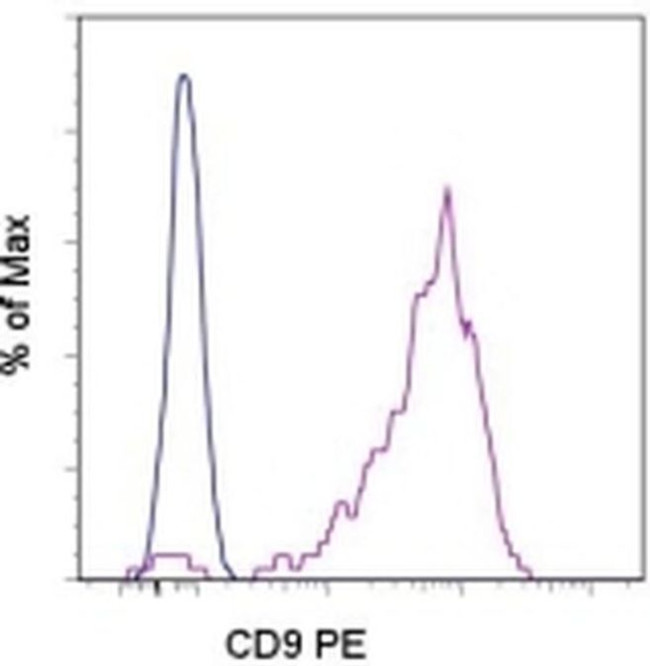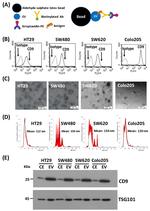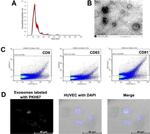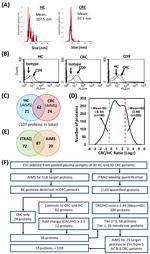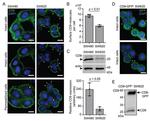Search Thermo Fisher Scientific
Invitrogen
CD9 Monoclonal Antibody (eBioSN4 (SN4 C3-3A2)), PE, eBioscience™
Product Details
12-0098-42
Species Reactivity
Published species
Host/Isotype
Recommended Isotype Control
Class
Type
Clone
Conjugate
Excitation/Emission Max
Form
Concentration
Purification
Storage buffer
Contains
Storage conditions
Shipping conditions
RRID
Product Specific Information
Description: The eBioSN4 monoclonal antibody reacts with human CD9. CD9 is a 24 kDa member of the tetraspanin family, whose members are characterized by the presence of 4 hydrophobic transmembrane domains. CD9 is expressed in platelets, eosinophils, basophils, pre-B cells, activated T cells and neural cell lines. Furthermore, CD9 expression has been associated with a malignant phenotype, including expression on 90% of non T cell acute lymphoblastic leukemia cells and on 50% of chronic lymphocytic and acute myeloblastic leukemias. In platelets, CD9 is expressed in alpha-granules and through association with the integrin alphaIIb/betaIII plays a role in platelet aggregation, as demonstrated by the use of anti-human CD9 antibodies. CD9 has also been shown to induce the aggregation of pre-B cell lines, and the adhesion and migration of pre-B cells and Schwann cells. Additionally, it has been demonstrated that CD9 is able to provide a co-stimulatory signal for T cells independently of CD28, in the absence of antigen-presenting cells. Binding of the eBioSN4 monoclonal antibody partially cross-blocks binding of another anti-human CD9 monoclonal antibody, MM2/57.
Applications Reported: This eBioSN4 (SN4 C3-3A2) antibody has been reported for use in flow cytometric analysis.
Applications Tested: This eBioSN4 (SN4 C3-3A2) antibody has been pre-titrated and tested by flow cytometric analysis of normal human platelets. This can be used at 5 µL (0.06 µg) per test. A test is defined as the amount (µg) of antibody that will stain a cell sample in a final volume of 100 µL. Cell number should be determined empirically but can range from 10^5 to 10^8 cells/test.
Excitation: 488-561 nm; Emission: 578 nm; Laser: Blue Laser, Green Laser, Yellow-Green Laser.
Filtration: 0.2 µm post-manufacturing filtered.
Target Information
CD9 antigen is a glycoprotein expressed on the surface of developing B lymphocytes, platelets, monocytes, eosinophils, basophil, stimulated T lymphocytes and by neurons and glial cells in the peripheral nervous system. CD9 belongs to a family of membrane proteins termed tetraspanins which transverse the membrane four times. In pre B cells and platelets, CD9 antigen regulates cell activation and aggregation possibly through an association with the integrin CD41 / CD61 (GPIIb / GPIIIa). CD9 is involved in cell motility, osteoclastogenesis, neurite outgrowth, myotube formation, and sperm-egg fusion, plays roles in cell attachment and proliferation and is necessary for association of heterologous MHC II molecules on the dendritic cell plasma membrane which is important for effective T cell stimulation. CD9 functions in many cellular processes including differentiation, adhesion, and signal transduction, and expression plays a critical role in the suppression of cancer cell motility and metastasis. CD9 is also considered as metastasis suppressor in solid tumors.
For Research Use Only. Not for use in diagnostic procedures. Not for resale without express authorization.
How to use the Panel Builder
Watch the video to learn how to use the Invitrogen Flow Cytometry Panel Builder to build your next flow cytometry panel in 5 easy steps.
Bioinformatics
Protein Aliases: 5H9; 5H9 antigen; antigen CD9; BA-2/p24 antigen; BA2; CD9; CD9 antigen; CD9 antigen (p24); Cell growth-inhibiting gene 2 protein; Leukocyte antigen MIC3; motility related protein-1; Motility-related protein; MRP-1; p24; sCD 9; sCD9; soluble CD 9; soluble CD9; Tetraspanin-29; Tetraspanin29; Tspan-29
Gene Aliases: BTCC-1; CD9; DRAP-27; GIG2; MIC3; MRP-1; TSPAN-29; TSPAN29
UniProt ID: (Human) P21926
Entrez Gene ID: (Human) 928

Performance Guarantee
If an Invitrogen™ antibody doesn't perform as described on our website or datasheet,we'll replace the product at no cost to you, or provide you with a credit for a future purchase.*
Learn more
We're here to help
Get expert recommendations for common problems or connect directly with an on staff expert for technical assistance related to applications, equipment and general product use.
Contact tech support
